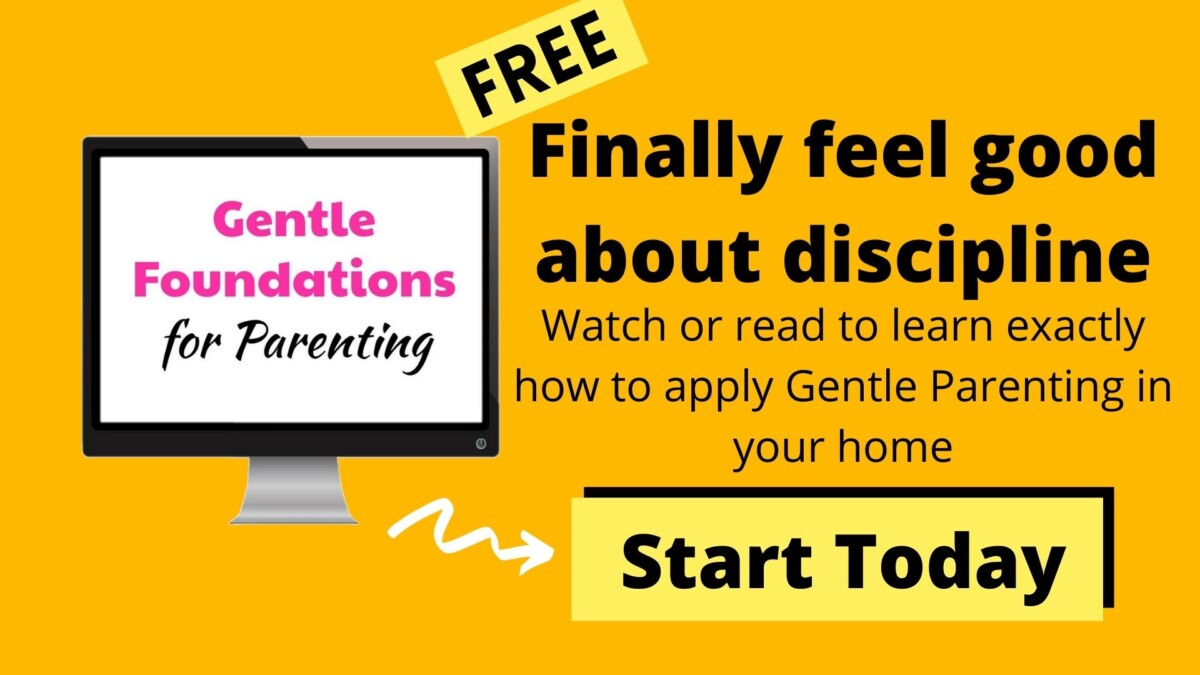Are you dealing with toddler tantrums and meltdowns in your home? They can be tricky and exhausting to deal with, so in this article I will completely break down everything you need to know about toddler tantrums, and how to work through them using Gentle Parenting.

(This post might contain affiliate links, which means if you happen to buy a product I love then I may get a commission – at no extra cost to you! For all the Ts and Cs go here.)
The screaming, the crying, the angry fits…are you dealing with temper tantrums and meltdowns with your toddler or older child?
This is a normal part of childhood, but as a parent it can be exhausting to face everyday, and we need to skills to help our children cope, and, to hopefully have fewer tantrums.
In this guide I’m going to give you the full breakdown of all things tantrums and meltdowns, with respectful strategies to make it easier for you to deal with. I am a teacher of Gentle Parenting, so everything will be inline with effective discipline and with the long term goal to help your child develop emotional intelligence.
If you want to learn more about Gentle Parenting in general so you can apply it to more areas of parenting, be sure to sign up for my free course, Gentle Foundations for Parenting, below.
Feel free to use the table of contents to read the sections most pressing to you.
#1. Toddler Tantrum Basics
What are tantrums?
Tantrums, at any age, are an emotional response, and not bad behaviour.
They can start at 18 months (or even sooner) and last until a child is 5 years old or more.
When a toddler is having a tantrum or meltdown they may be crying, screaming or even getting aggressive. Sometimes it’s easy to tell what triggered it and other times it seems (to the parent) to be completely random.
However, tantrums are an emotional response to something. As adults we have (hopefully) learnt appropriate ways to express our emotions, but toddlers and young children are still learning how to do that. They feel their emotions in a very BIG way, and they don’t have appropriate ways to express them, so it comes out in the form of a tantrum.
Some may say that tantrums and meltdowns are different. That tantrums are anger related and meltdowns are sadness, but often as the parent it’s hard for us to truly make that distinction, so I use both “tantrum” and “meltdown” to mean an emotional response.

Tantrums/meltdowns are a child’s form of communication, often communicating that they are in emotional distress.
Since they are very upset, and are still learning to regulate their emotions, what they really need is HELP from their parent. A tantrum is not the beginning of a battle between parent and child (even though as the parent it might feel that way). Our attitude about what a tantrum is plays a really big role in how we handle that tantrum.
If you think a tantrum is “bad behaviour” then you might be tempted to encourage your child to suppress their emotions and “stop crying.” Instead if you recognize that they need your help to control their emotions, then you will see your role to help them and work together as a team.
Why do toddlers have tantrums and meltdowns?
What causes a tantrum can vary from child to child, but there are some common triggers:
- Hunger
- Anger
- Loneliness
- Tired
If your child is experiencing any of these things they are more likely to have a tantrum. Do you ever get cranky when you’re tired or hungry? You might be able to relate.

Toddlers and children though are very emotional and they feel their emotions in a much bigger way that adults. This is completely normal. But since they don’t have the language or skills to express those emotions in a healthy way, or sometimes the control over their life to fix the problem, they can often have a tantrum to express that emotion.
You might also find that your toddler has a tantrum when they don’t get what they want. This is common too, and it might be very frustrating for you as the parent. They might be asking for something they’re not allowed to have, and even though you tell them why they can’t have it they can still end up having a tantrum. Maybe they don’t understand what you are saying, but it can also be that they are so worked up emotionally that they can’t truly process what you are saying to try to rationalize with them.
At what age should toddler tantrums stop?
It varies from child to child. There are some toddlers who very seldom seem to have a tantrum and it lasts for a short amount of time, and others who seem to have frequent and long lasting tantrums – even if the parents are responding in the exact same way.
Everyone is just different.
So it is hard to give a guarantee of at what age a child should stop having tantrums because they can go through different seasons. Some parents say their child stopped having tantrums when they were 4 years old, but a lot of parents say it stopped around age 6.
The child is learning to regulate their emotions though, and like with any other milestone of learning, children can hit that milestone at different times.
It’s most likely though, that your child will start to have fewer and fewer tantrums to the point where it only happens now and then, until they eventually grow out of it.
When to worry about toddler tantrums
I would suggest though that first you try some of the strategies I am going to suggest here to see if that makes a difference, but if no matter what you do the tantrums continue or get worse and worse, you might consider seeing a doctor.
If your child hurts them self or others during the tantrum (even with you trying your best to keep everyone safe) you might want to see a doctor. Or if you are struggling emotionally to cope with their high intensity tantrums.
As a parent though you should follow your gut, if it seems like something isn’t right then you should feel free to see a doctor. Some children could have underlying causes to their tantrums such as sensory processing disorder, or something that is causing them physical pain.
However, tantrums are a very normal aspect of toddlerhood, and no two children will be the same so it’s difficult to compare.
Can tantrums be a sign of autism?
I wanted to address this specifically because many parents wonder this, especially if they have been struggling themselves to cope with their child’s constant tantrums and meltdowns. It’s easy to wonder if there is something bigger going on.
One of the major differences between a tantrum in a child who does not have autism and a tantrum in a child who does have autism, is goal oriented vs overwhelm.
A child without autism’s tantrum may be because of a certain goal – to be able to “do it them self”, or get something they wanted, or even to get some sleep.
However, a tantrum in a child with autism is usually due to being completely overwhelmed and overstimulated. Now, a child who does not have autism can still have a tantrum from being overstimulated, but that might not be the main cause of their tantrums.
A lot goes into the difference between these two types of tantrums, but I am just giving you an idea of one of the distinctions.
If your child has A LOT of tantrums, that alone is not a clear sign of autism. Many children have frequent tantrums, and it’s easy to think your child has more tantrums than any other child.
If you suspect that your child has autism though, definitely look into it and even consult a doctor. What you find online (and there is a lot of information out there that may help) can only tell you so much, but a professional will be able to ask questions specifically to your child.

How to stop toddler tantrums
When it comes to dealing with our toddler tantrums, the goal isn’t to stop the tantrum altogether.
If you’re just looking for information on how to discipline a toddler then I suggest you check out this article I wrote. I am all about Gentle Parenting here which means we are going to handle the tantrum in a way that will benefit the child.
So we are not going to try to simply stop the tantrum, because we already know that a tantrum is an EMOTIONAL RESPONSE and not bad behaviour.
A tantrum isn’t the same as your toddler throwing rocks at the car – you definitely want them to stop doing that! A tantrum is an emotional expression, and you can support them through that, the same way you might comfort a friend who is upset and crying.
Should you ignore toddler tantrums?
Our goal may not be to stop the toddler tantrum, but our presence is still needed during the tantrum so our child can be supported and comforted by us while they go through the tantrum.
Ignoring a toddler while they have a meltdown can often add fuel to the fire.
Keep in mind that tantrums are not manipulation or bad attention-seeking behaviour. Giving them your support while they have a tantrum does not mean you are “giving in” to what they want, or “rewarding bad behaviour”. You are supporting them and helping them to cope. You are their rock.
It’s really important to remember that a tantrum is an emotional response, and not “bad behaviour.”
#2. Your Basic Strategy to Handle Toddler Tantrums
The right mindset about toddler tantrums
Before we get into how to actually handle the tantrum in the moment, it’s important that as the parent we have the right outlook on tantrums and meltdowns.
Here are a few things I’ve already mentioned that as parents we need to remember:
- A tantrum is not bad attention seeking behaviour
- A tantrum is not a child’s way to manipulate an adult
- A child having a tantrum needs the adults help to be able to process their emotions, to calm down, and eventually learn how to regulate their own emotions
Check your goal
When your child is having a tantrum, what is your goal?
Your goal should be that long term your child learns to regulate their own emotions. This means they learn how to actually calm down (rather than being forced to “stop”) and find appropriate ways to express their emotions.
Consistency & Flexibility: Should I give them what they want?
A lot of times a tantrum happens because you refused something to your toddler. Maybe they reached for a knife, or maybe they reached for your glasses.
Most of the time people will advise you not to waver in your decision. If you told them no, then let it stay as a no.
I completely agree with this, because consistency is important. Many will say you don’t want your toddler to learn that to get what they want they should have a tantrum. This is why sticking with your first answer is usually a good idea.
However – sometimes as parents we should be flexible as well, because it’s easy to just blurt out a “No,” and then realize actually it might have been ok.
Often times I have told my daughter “No,” as a reaction, and she has started to cry, and I realize right away that I didn’t actually need to say no – it was just the easy response for me. Sometimes she has wanted to play with my glasses when we are sitting in a waiting room, and she likes to take them off my face and put them back on. She can be very gentle.
So believe it or not, as consistent as I try to be, there have been times where my “No,” has changed to a “Yes.”
NOT because she manipulated me, but because I realized I made the wrong call.
I said my “No,” out of being impatient, tired or frustrated, not realizing that it was actually a small ask that I could handle just saying “Yes,” to instead.
Sometimes I have even used this phrase with her, “Oh sorry, I didn’t realize it was that important to you.”
Because the thing is – she’s a toddler. After she says no she doesn’t have the skills (language skills, social skills and patience) to say, “But please mommy, I really want to. I’ll be careful.”
No. She’s a toddler…so she cries and expresses herself that way instead. She doesn’t have the restraint to be patient.
This really isn’t manipulation, because I know even sometimes I can ask another adult for something and they might say no at first, but I present my case and they can change their mind. Have you ever been sitting on the couch watching TV with someone and asked them if they could get up and get something? They groaned at first, but eventually you talked them into it?
That’s real life.
So for the most part, be consistent (which for me means trying to say yes to all reasonable requests instead of say no to reasonable requests). I won’t change my “No,” to a “Yes,” if it’s an unreasonable request (like playing with the knife) but I choose to be flexible when I realize I’ve said no to a reasonable request.
Don’t make “No,” your default response to your child.
Lizzy Mash
Know your power
As the parent your presence and comfort means the world to your child. Don’t misjudge the impact that you can have to help your child regulate their emotions.
Find your calm
In order to truly be a comforting presence to your child during their meltdown, it’s important that you are able to stay calm. It’s easy to get overwhelmed and spill into their emotions, but if you are able to stay calm and communicate calmness, it will be easier for your child to join you there.
I always like to remind myself that it’s my job to model self-control and self-regulation to help the child calm down too.
If you find yourself getting worked up, try to calm yourself down by taking a deep breath to start.
There are a lot of great strategies parents can use to calm down if they’re starting to lose their cool too. I’ll leave it to Lauren from Military Wife and Mom to tell you her 5 strategies to be a more patient mom and to calm down when things are starting to get rough. All 5 of these strategies have worked for me, so I suggest you check it out too.
The Gentle Parenting approach to discipline
Before we get into the strategies to handling a tantrum, I just want to remind you that I empower parents to discipline using Gentle Parenting approaches.
In a nutshell, what I’m teaching is a respect based strategy to discipline that relies on our connection to our child, instead of punishments or rewards. The long term goal is for children to choose to do the right thing on their own, not to only do the right thing because they’re motivated by avoiding a punishment or getting a treat.
So this approach reflects in how a child is corrected, which I’ve broken down into the Gentle Parenting Pyramid to give you a better idea of what I’m talking about. Understanding this effective approach to discipline makes handling tantrums so much easier. You can sign up to learn more (for free) here.
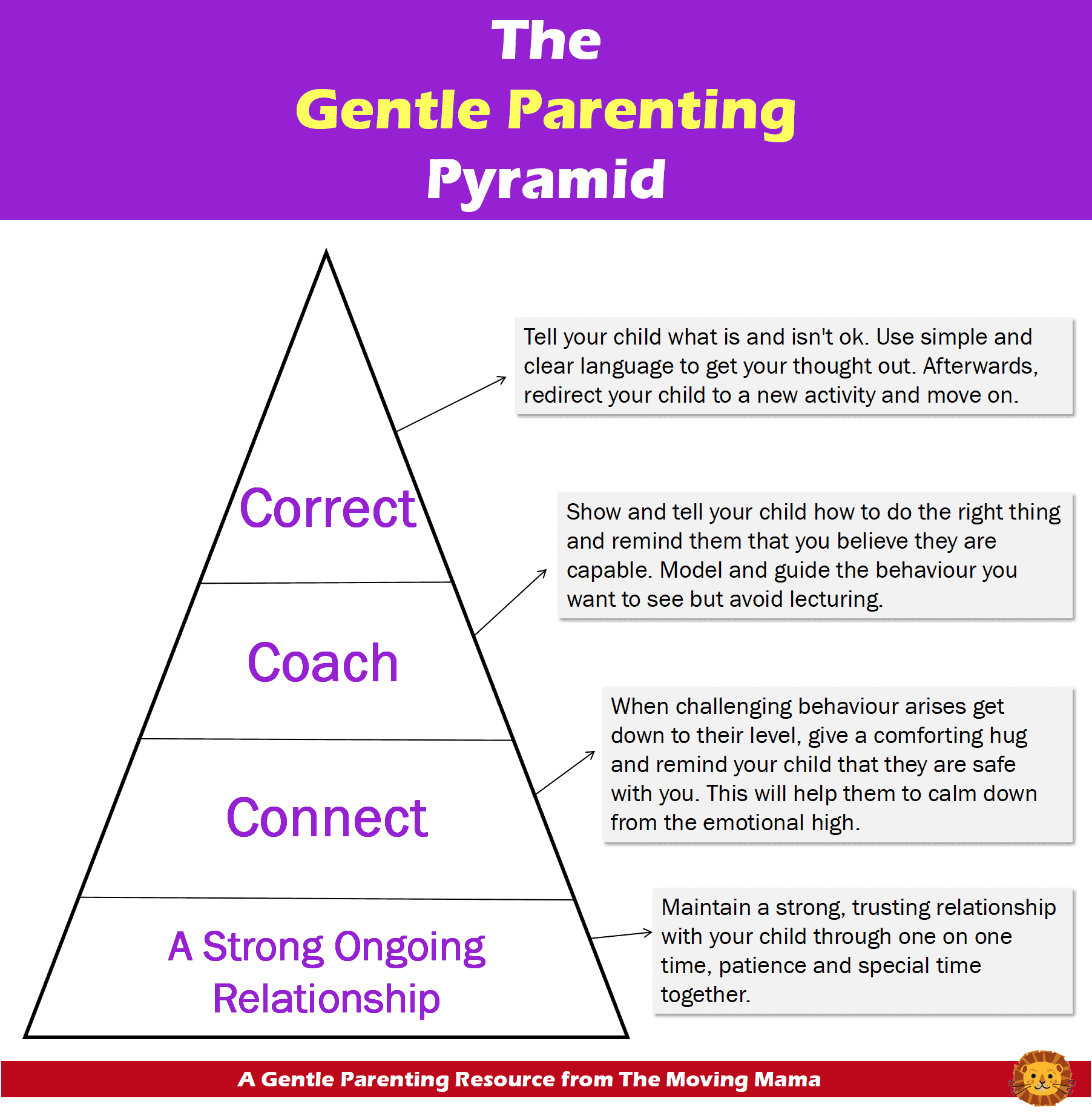
Step 1: Communicate with Body Language during your Toddler’s Tantrum
When your child’s tantrum begins, and you’ve already made sure that you are calm, you should start by offering physical comfort and connection.
This can mean getting down to their level, making eye contact, using a comforting voice, offering a hug, etc.
I try to make sure my body language is very open for the toddler so they know they can fall into my arms at any moment. They might not be calm, but I want to communicate calmness to them.
Focusing on physical comfort before comfort in words is important because sometimes we are still trying to gather our thoughts as we react to our child’s intense emotions. As you get down to their level to offer physical comfort you can start thinking about what you’re going to say, which I will help you with soon.
Emotionalize before you Rationalize
With an older child who is often very reasonable, you might be tempted to rationalize away the tantrum. Are they crying because you’ve ran out of milk? It’s tempting to expect that telling them “it’s all gone” will make the tantrum stop.
You can tell them that in a matter of fact way, but often times if they’ve already entered tantrum zone that might not be helpful. During a tantrum the brain is working on a strictly emotional level, their logical side of the brain isn’t the one calling the shots in that moment.
First you need to relate to them on an emotional level, so the emotional side of the brain can relax, and it’s only then that your reasonable child will be able to accept the rationale behind why they can’t have anymore milk.
This is why your connection and support is very important. Your words should center around the emotions, and your presence should be comforting.
That is why starting with physical comfort is so important, because physical comfort definitely relates on an emotional level, whereas words can relate on an emotional level, or on an (unhelpful) rational level.
Your physical comfort and body language can help your child to calm down emotionally, only after they’ve calmed down emotionally will they be able to think reasonably again.
Forms of physical comfort to use for the tantruming child
Here are different ways to use your body language to community calmness, security and comfort to your child. Remember, your goal isn’t to stop the tantrum in its tracks, but it’s to help your child process their emotions. If they feel safe and comforted with you it will be easier for them to process their emotions.
- Relax your body (loosen your shoulders, check your facial expression) to be sure your body is giving off a calm vibe
- Get down to their level
- Make eye contact
- Put a hand on their shoulder
- Give a sympathetic smile
- Offer a hug
- Offer to hold them or cuddle
- Stay very close even if they are still crying too hard to accept physical comfort yet
And there are more ways to give your tantruming toddler comfort of course, so do what feels right for your child’s specific needs
Offer Physical Space
During a tantrum your child might not want to be physically close to you.
That’s ok too. They need to figure out how to cope in a way that’s best for them.
If they don’t want the hug, or to be picked up, or to be touched at all, then don’t force it on them. Give them exactly the space they need and try to stay at their level if you can. You can also say, “I’ll be right here if you need me,” if they clearly need a lot more space.
It will really depend from child to child, and on their specific tantrum. If you learn your child’s patterns it may become easier to understand what kind of space they need and when. As they get older that might also change.
An older child might want to be alone in their room and cry, and that’s ok. You can respect the space they need but still tell them, “If you need me to come in please call me,” or every now and then knock and ask if they’d like you to come in.
It’s not uncommon that a toddler or child will want space during one part of a meltdown, but at the end want physical closeness. Some tantrums even end with a child sniffling in their parents arms and drifting to sleep after the exhaustion of the tantrum.
What your body says to your tantruming child is important, and offering them physical space when that’s what they clearly want is also important, and to be in tune with them if they later do want physical closeness.
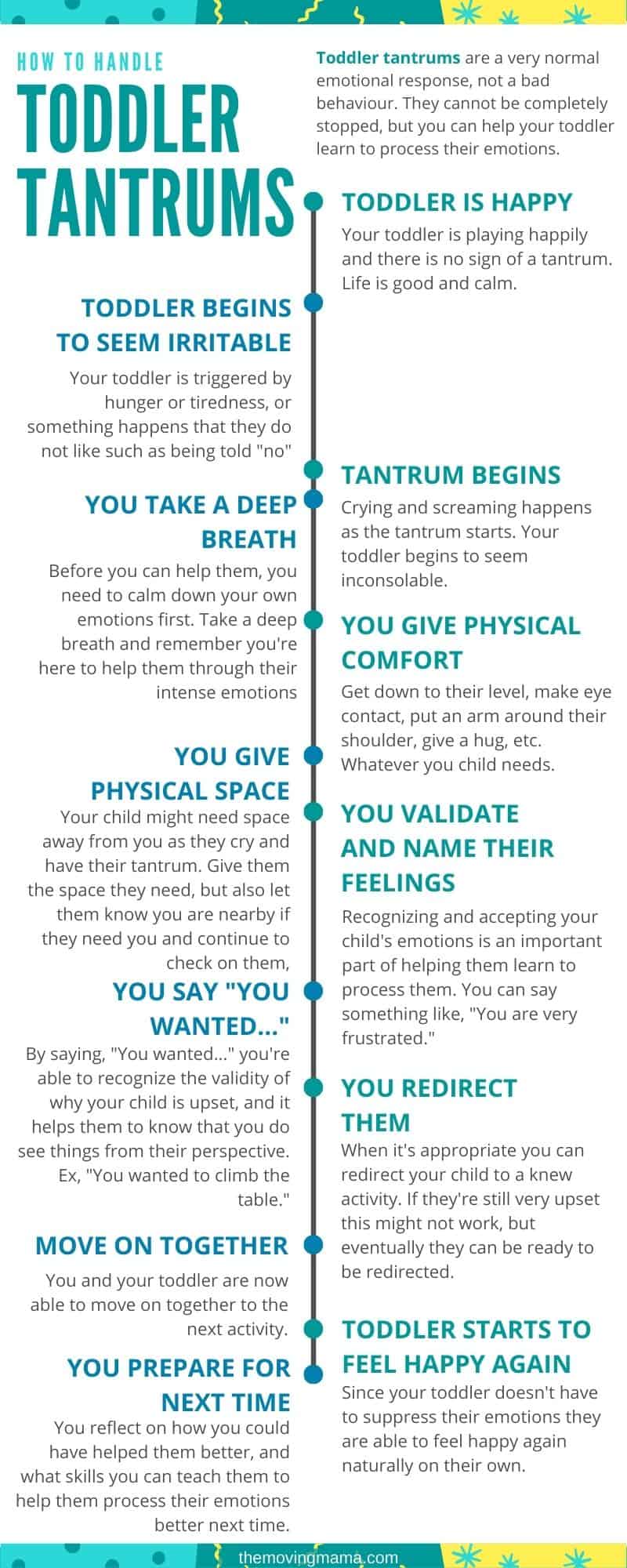
Step 2: Communicate with Words during your Toddler’s Tantrum
After making sure you are calm, and starting to offer the physical comfort your child needs, you can next start to use words to comfort your child.
It’s worth remembering here that tantrums are an emotional response, and not a bad behaviour. Your child might react inappropriately with those emotions, perhaps with aggression, but we’ll get to that in a later section.
As you speak to your child, remember to stay calm. Your words to your child should be a TOOL for them to learn how to process their emotions.
Name it to tame it – by Dr. Dan Siegel
“Name it to tame it” is an amazing strategy taught to us by Dr. Dan Siegel in one of my all-time favourite books, “The Whole Brain Child.”
The idea is that when your child is able to identify and NAME the emotion they’re experiencing it makes it easier for them to TAME that emotion.
For a toddler who is having a tantrum, this might mean you say, “I can tell you’re feeling very sad right now because there is no milk left.”
For an older child, you might prompt them to label the emotion on their own. If they’re able to recognize their own emotion it will give them power over it.
I would highly recommend reading more of Dr. Dan Siegel’s strategies from his book. It is the number 1 book I recommend to parents considering Gentle Parenting, especially for spouses who need “proof” that it really works.
Say “You wanted,”
Another powerful tool is to connect with them through the “You wanted,” method where you basically give your toddler the words to say what they wanted while expressing that you understand WHY they’re feeling something.
“You wanted more milk.”
“You really wanted to climb up there but it wasn’t safe, so I had to bring you down.”
“You wanted that toy but your brother was still playing with it.”
This helps your young one to feel connected to you because you understand why they’re feeling that way. It may seem simple but it can have an absolutely powerful effect, especially if your toddler doesn’t have the skills yet to express something like that on their own.
It shows you understand why they’re feeling that way.
Step 3: Move on Together
Once the intensity of the tantrum has passed, prepare to move on together.
“Why don’t we go play outside now.”
This isn’t meant to distract them from their emotions, but it just helps to pick yourself up and carry on if you have something to do next.
With a very young toddler sometimes tantrums can be shortened with redirection, “Oh, you wanted your brothers toy but he’s still playing with it, here have this one instead.”
There are times where redirection can work easily, and other times where it won’t. At the end of a tantrum though it’s different, and moving on to another activity helps.
It also helps to let them know what you’ll be doing next while the tantrum is happening. “When you’re ready we are going to put on our shoes and go outside.”
This actually helps a lot because it lets your child know what’s going to happen when the tantrum ends – and that it indeed will end.
This is different than saying something like, “You need to stop crying so we can go outside,” or “If you don’t stop crying we’re not going outside!” Those phrases encourage a child to suppress their emotions and that’s not our goal at all here.
Instead, we’re allowing them to have the tantrum, allowing that emotion to be expressed, but we’re also letting them know what will happen next.
And when they’re sniffling and starting to pick up their shoes, hop right in beside them and move on together. Get those shoes on and go outside!
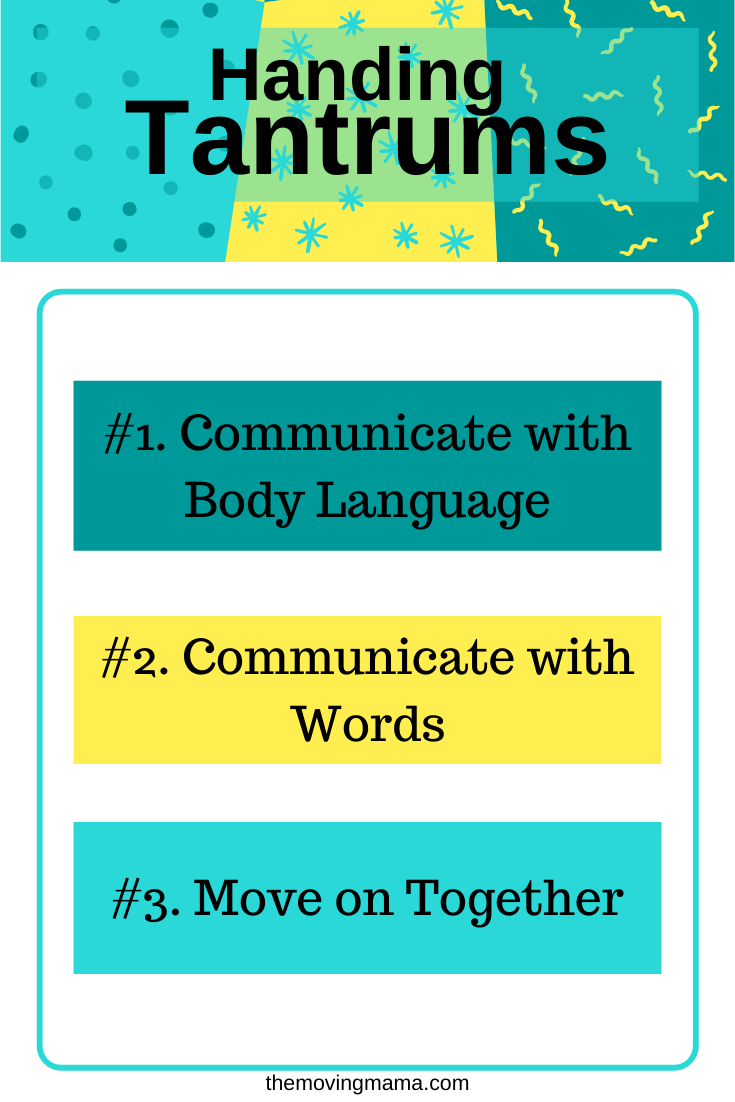
Things to avoid
Hopefully these strategies will be helpful to you next time your child is having a tantrum. There are a few things though that we want to be sure to avoid while our child is having a tantrum.
You might have been raised with these approaches or have people in your life who encourage you to use them, but they’re not supportive of our overall goal for our children.
- Saying, “Stop crying!”
- “If you don’t stop crying I’m going to [punish you]” (Ex. I’m not going to take you to grandmas, I’m going to take away your toy, etc.)
- Labelling them in a negative way, such as “you are a cry baby/naughty child/terrible two” etc.
- Having an adult sized tantrum that results in yelling or snapping at them
- Rolling your eyes or making passive aggressive remarks
You might have done some of these things before (I know I have) but since they’re not in line with our goal to help our child learn to regulate their emotions it’s best to avoid these things and focus on the other approaches I’ve taught instead.
Remember though – it’s much easier to avoid such things if we are calm to begin with! Don’t forget to check out how to be a more patient mom from The Military Wife and Mom.
#3. Preventing Toddler Tantrums
Is it possible to prevent toddler tantrums?
YES, it is possible to prevent toddlers tantrums, BUT it’s not possible to prevent all toddler tantrums. If our goal was to completely eliminate tantrums that might mean we are forcing our child to suppress their emotions, or we’re becoming very permissive in our parenting to avoid any outbursts.
Toddler were just made this way, they’re going to have tantrums, but there are definitely appropriate ways we can prevent them or at least make them a bit more manageable.
Learn to recognize their triggers
What makes your toddler have a tantrum?
- Hunger?
- Tiredness?
- Loneliness?
- Overstimulation?
We can often start to see a toddler tantrum brewing before it even starts!
Start to pay attention to when your toddler has a tantrum and try to figure out what’s causing it. Start thinking about how you can avoid those triggers and then plan ahead.
Plan Ahead
If you plan ahead, you will be able to prevent many tantrums caused by things like hunger and tiredness.
It might seem obvious to avoid grocery shopping close to nap time, but sometimes it can seem convenient if we are already out. You don’t just want to avoid naptime in general, but you probably want to make sure to get home with a cushion of time for them to be able to wind down.
It’s also a good idea to bring snacks with you wherever you go, or make sure to serve meals on time so your toddler doesn’t become “hangry” (hungry + angry).
Whatever your toddler’s triggers for tantrums are, if you can plan ahead to avoid them it will be a huge help to prevent trigger caused tantrums.
More Connection
If you are able to provide more quality connection time with your child, you will be able to help develop more trust and security with them.
This means that when your toddler is feeling completely overwhelmed with their tantrum emotions, they will still feel safe and secure with you.
This sense of trust and security can also help your toddler when you ask them to do something, or tell them it’s time to go. They might not like what has to be done, but trusting you a lot can make it easier for them to do it.
Of course this is a natural bond we have with our children, but there are ways to improve our connection and security with them.
Try giving them more one on one time where you are deeply focused on them (no distractions). And remember, it’s definitely about quality over quantity! You can be a really busy mom, but even short moments of pure focus on the one child is a powerful tool!
Routines and Predictability
It’s always a good idea to give your toddler a heads up about what’s going to happen next and to generally stick to a routine.
Think of how frustrating it would be if you never had control over your schedule. If as soon as you started to have fun you were rushed over here to do something else…then rushed over here for something else…then rushed into the car and you didn’t even know where you were going!
You’d feel pretty caught off guard every time that happens! You’d feel frustrated!
That’s why it’s important for toddlers to have routine and predictability. Routine doesn’t have to mean every hour of the day is the exact same everyday, but a general outline or schedule is helpful (wake up, get dressed, have breakfast, play, etc.) and if we plan on going somewhere that day it’s helpful to communicate that to our child well in advance. If they’re looking forward to playing after breakfast, but actually you two have to go out for an appointment, it helps to tell them that right from the get go!
“Just so you know, after breakfast today we won’t have any time to play. We have to get in the car and go to the doctor.”
Keeping them updated with the next activity (especially if it’s outside the regular routine) is really important. One thing you might already know about toddlers is that they desire control and independence. They want to “do it” on their own. When we tell them what the next activity is it helps them not to feel like their life is out of control!
Surprises in the schedule can be very upsetting and confusing for toddlers and lead to a tantrum!
It’s also important to note that practicing the habit of telling them what’s next is a form of showing respect to our toddler.

Transitions between activities
On top of routines and predictability, it’s also important and powerful to use transitions when moving from one activity to another.
Transitions is something that was drilled into my head in college when I was taking Early Childhood Education, the idea is basically to make sure moving from one activity to the next doesn’t feel so abrupt, but instead it feels smooth and natural.
This means first some warning that the activity is ending (and letting them know what’s next) and then using something like a song or game to make the process easier.
So maybe when it’s time to put the playdough away you can make up a song and sing, “It’s time to put the playdough away, it’s time to put the playdough away, yes indeed, it is time, to put the playdough away!”
Or when it’s time to leave the park you can play a game on the way to the car, like running together.
These smooth transitions make it much easier for your toddler than instead an activity they love being suddenly over and then having to move on to a less desired activity.
Consistency
To prevent tantrums and meltdowns in your toddler, it’s also important to be consistent with them. This can sometimes be harder than it seems.
Sometimes it’s easy to say, “No,” about something at first, but when your toddler keeps trying for a “yes” it can maybe wear you down. Say they try climbing on the table, and you redirect them to get off the table, and tell them that it’s not safe. They might try 100 more times that day to go on the table, and it’s up to us to have the same, consistent, patient response. This requires a lot of our energy! We can get tired of always having to get up and redirect them, by the 101st time we might just think, “Oh I guess it’s fine…”
This does not create a consistent environment for our toddler, this doesn’t teach them that we are going to be consistent with our answers. Actually it teaches them if they just keep trying we might just change our minds. I don’t think it’s malicious of toddlers to do that, that’s just how they can start to think things work – after 100 no’s I’ll get 1 yes!
I want to be clear though, that my attitude about this is simply to create a consistent environment, and I would avoid saying something like, “I’m not going to give in to what she wants!” This sort of language can create an us vs. them attitude with our child, and we don’t want that.
I will say though, that there are times were you might change your mind. Maybe you see them touching something and you instantly react to them by redirecting/stopping them, but then you realize two things:
- It’s actually probably fine for them to touch that, and you just overreacted without thinking about it
- You don’t have the energy to keep redirecting them over and over again
If you can assess that quickly, then I think it’s very valuable to just say something like, “Actually, maybe I responded too quickly, it looks like you are being safe, so it’s ok, you can continue.”
The quick assessment is the important part though, not after you’ve already redirected them a million times. If you get in this habit then you’ll become less likely to overreact anyways.
Respect
Overall, all these forms of preventing tantrums in toddlers comes down to how we respect them.
Each and every one of these strategies is about respecting them as a whole person. They might be a very little person, with a brain that still has a lot of developing to do, but they are a whole person.
Respect is at the core of Gentle Parenting which makes handling tantrums in this way possible. The first lesson I teach in my free course Gentle Foundations for Parenting is about respect, and you can sign up for it here. It’s an informative video course that has given hundreds of parents their first step into using Gentle Parenting to change what discipline looks like in their home.
If you struggle to know what to say during the tantrum download this free tantrums script.
#4. Teaching Children to Regulate Emotions
Before we talk about how to teach children how to regulate their emotions you might wonder if children have the ability to regulate their emotions?
Emotional development does not happen overnight, and children have varying abilities when it comes to regulating their emotions.
First let me ask you though, are you able to regulate your own emotions? Do you ever feel stressed and end up snapping at your spouse? Ever yell at other drivers? Ever cry even though you’re trying to keep it all together?
Keeping our emotions out of the way all the time is not a realistic expectation! It’s great to be able to control them, instead of letting emotions control you, but learning to regulate emotions doesn’t mean you will stop having emotions.
So in a way, some children are able to regulate some of their emotions some of the time.
They’re going to have good days and bad days, and the skills we teach them are super important for them to be able to learn to regulate those emotions. They really need strategies and skills and that’s what we are talking about in this section.
It’s important to remember though that emotional intelligence takes time to develop, and every child is going to be different.
One day your child might be able to deal with their disappointment without having a meltdown, but the next day they might just be a little bit more tired and they just can’t handle the disappointment without crying.
The goal isn’t to teach children to suppress their emotions though, the goal is to teach them to process the emotions.
Here is a great article that talks about the ages and stages of empathy which I think can help us to better understand how emotional understanding takes time to develop in children.
Time In
One important way that we can teach children how to regulate their emotions so they can handle tantrums better is by utilizing Time-Ins instead of Time-Outs.
Let me show you what that looks like through one of my Instagram posts.
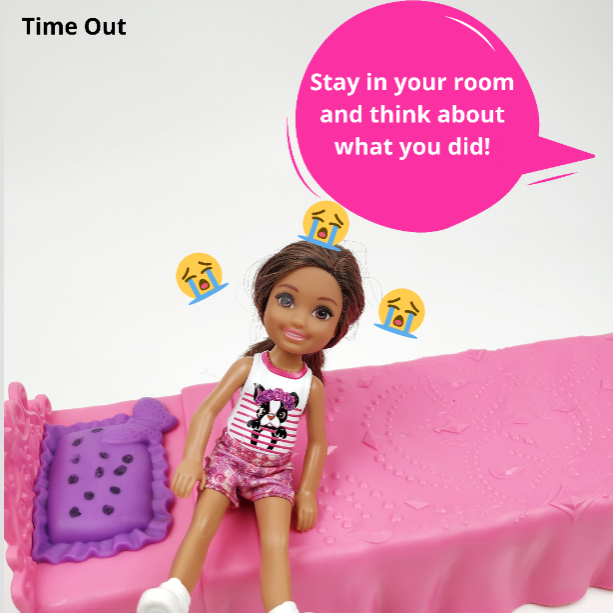
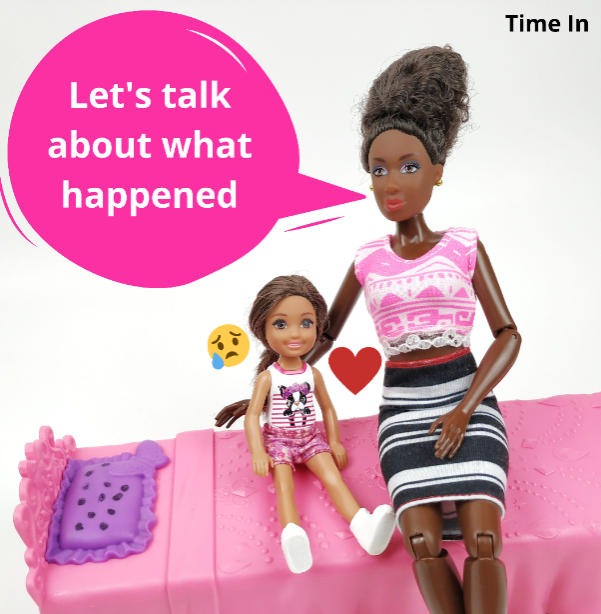
As you can see, a time-out is time the child spends alone and it is treated as a punishment, where as a time-in is time spent together with the parent to connect and calm down.
We have already talked about the importance of connecting with our child to help them calm down during a tantrum.
The practice of time-ins though will help them to learn how to regulate their emotions, if they’re able to learn that when they’re having a hard time emotionally that they should take a break. Eventually your child could start to notice on their own that they need to take a break from the situation so they can process their emotions and calm down on their own.
Calm down corner
A calm down corner is a great addition to practicing time-ins, and it’s basically a comfortable space (or literal corner) for your child to go alone (or with you) to calm down when they’re having a hard time emotionally.
I’ve created this Calm Down Corner Kit to guide you thorugh setting up a calm down corner with multiple printables for you to use in the corner.
Here are a few key features many parents like to add
- A comfortable place to sit (like a bean bag chair or pillow)
- Books
- Facial emotion chart (more on that next)
- Sensory toy (ex. Jar with water and sparkles to move around)
- Soft toys
You can keep most of these items in a basket even and your child can go with that basket and sit on their bed if you don’t have enough space for a designated space in the house.
The idea of the calm down corner though, is that it’s a safe place for your child to relax when they’re having a hard time emotionally. You can have some “time-ins” with them in the space to help them learn to use the different devices to help them calm down. Encourage them to hug a pillow or to watch the sparkles float around in the jar.
When should you send your child to the calm down corner?
It’s important to remember that the calm down corner is NOT a punishment, so try not to think of it that way. Instead, think of it as a tool to help your child process the very big emotions they are having.
Let’s say two of your children are playing but one is getting increasingly annoyed with the other one, to the point of highly intense emotions and borderline meltdown. They may have even shoved their sibling as this has been heightening.
If you’ve already introduced them to the calm down corner you can say something like, “Hey buddy, it looks like you’re having a tough time right now, how about you go to the calm down corner so you can take a break while you process your emotions. Do you want to go alone or do you want me to come with you?”
Notice how you would word this treats the calm down corner like something to help THEM, and NOT as a punishment for their intense emotions. You can also of course address the shoving of the sibling, but remember that when children are very emotional it’s hard for them to think rationally, so whether or not that is the right time to bring it up can depend on the situation.
As with everything in Gentle Parenting, it’s about respecting our child, and out of respect for them we want them to learn to process their emotions (because even for a child it doesn’t feel good to have out of control emotions) and so we are helping them by leading them to the calm down corner.
How long should they stay in the calm down corner?
Remember that this is not a time-out, and the purpose of the calm down corner is to help the child process their emotions and so they can eventually calm down.
So once they are ready to be done in the calm down corner is how long they should stay there. If they feel better than they can go back and play. If you ask them if they’re feeling better now, and if they feel ready to go play with their sibling again it will help them to listen to their emotions. If you tell them they have to stay in the calm down corner for 5 minutes than that no longer makes it about their emotions, but instead about time simply passing. Teach them to listen to their feelings to know when they’re ready.
Facial Emotion Chart
Another great tool that you can use in the calm down corner or just keep it around the home, is to use a facial emotion chart. Basically this is a piece of paper, or a bunch of cards, that shows different facial expressions.
A young child might struggle to express their emotions with words, but they’re more likely to be able to point to a picture of a face to tell you which emotion they identify with.
There are lots of charts like this for free online. If you search something like, “kids emotion chart” you’ll find a lot of different styles you can choose from. For younger kids charts with the faces of real kids (not just drawings) can be the most useful.
This will help you child learn to regulate their emotions because they will start to listen to their emotions to identify them. When you ask them to point to the face that’s closest to what they’re feeling it will make them have to think, “Hmm, what am I feeling?” and this is really important for learning to regulate emotions. Children need to know what they are feeling on the inside!
A chart just like this, plus other helpful resources, are all included in my Calm Down Corner Kit.
Talking about what happened
#5. Aggressive Toddler Tantrums
In this section we will be talking about aggressive tantrums. This is when your child becomes aggressive and violent during their tantrum. This is more common during toddler tantrums, but it can happen with children as well when they’re having a tantrum.
As a parent this can be really hard to deal with, and it can also be very triggering if your child is hurting you or a younger sibling in the process. Aggression can cause us to react in a very protective mode, and our fight or flight brain can take over!
Take a deep breath, stay patient, and you’ll be able to work through this with them!
Why do child and toddler tantrums become aggressive?
Aggression during tantrums usually begins during toddlerhood, so let’s start with that age.
Toddlers are still learning to control their bodies, and also how to regulate their emotions. When they are hurting on the inside and feel frustrated, angry etc. they can end up acting aggressively, such as hitting.
Children often hit if they feel scared, this might not come out in a full blown tantrum, but it could come out in a burst of overwhelming emotion. If you struggling specifically with this kind of hitting here is an excellent resource from Aha Parenting.
If your child hasn’t learnt how to deal with their emotions or conflict, or if they’ve been responded to with aggression, then they might still act aggressively during a tantrum even if you feel they are “too old” for that.
Biting, hitting and kicking you during a tantrum
If your child is biting, hitting or kicking you during their tantrum, what can you do?
First of all, stay calm. They are allowed to feel what they feel, and they don’t know the appropriate ways to handle their emotions.
First, you can physically intervene from allowing the aggression against you to continue. Firmly but gently remove them, or you can physically move out of the way.
Tell them that biting/hitting/kicking hurts your body.
Validate their feelings. “I know you’re upset about ____ but everyone still has to be safe when they feel that way.”
Their tantrum can still continue from there with crying and screaming, but the important thing is that no one is getting hurt. Those feelings are allowed, they just need to be expressed appropriately.
Hurting other children during a tantrum
If other children are involved during the tantrum it’s quite likely they can get caught in the aggression in the tantrum. You will want to keep the other children safe, and you might find yourself feeling overwhelmingly defensive especially if it’s your younger child who is getting hurt. You might also be especially stressed if your child is hurting someone else’s child.
Remember to take a deep breath and proceed with calmness.
First, intervene to stop the hurting from happening right away. This can mean firmly but gently physically removing your child from the other child. Make sure to check on the hurt child to be sure that they are ok. This is a good opportunity to model empathy. Avoid panicking or saying something shame-filled to the child who did the hurting like, “How could you do something so mean to your little brother!?”
If your child is calm enough, this can also be a good teaching moment for apologies. Apologies do not need to be forced, but instead modeled.
With your child who did the hurting, turn to the child who was hurt and say something like, “I am really sorry that you got hurt.” If your child wants to add to the apology that’s fine, but if they say nothing at all, that’s fine too. They will learn.
If your child is still having the tantrum though, it may be necessary to remove them from where they are playing to help them calm down, and this is also part of keeping the other child safe. Help them to calm down as you normally would.
Once your child is calm and able to think reasonably that’s when you might want to explain that hitting/biting/kicking etc. hurts. Avoid shameful language, but just state the facts. Aggression hurts, and it can make other children feel sad or not want to play anymore.
You can also help you child by letting them know what they should do next time in that situation. Maybe they should have called you over to resolve the conflict, or used their words, or just gotten up and walked away. Whatever would have been appropriate for that situation and for your specific child let them know so they’ll be equipped for a next time.
Remember, it can take children awhile to develop empathy, so it might seem obvious to you that they shouldn’t hurt others, but they might still be learning that.
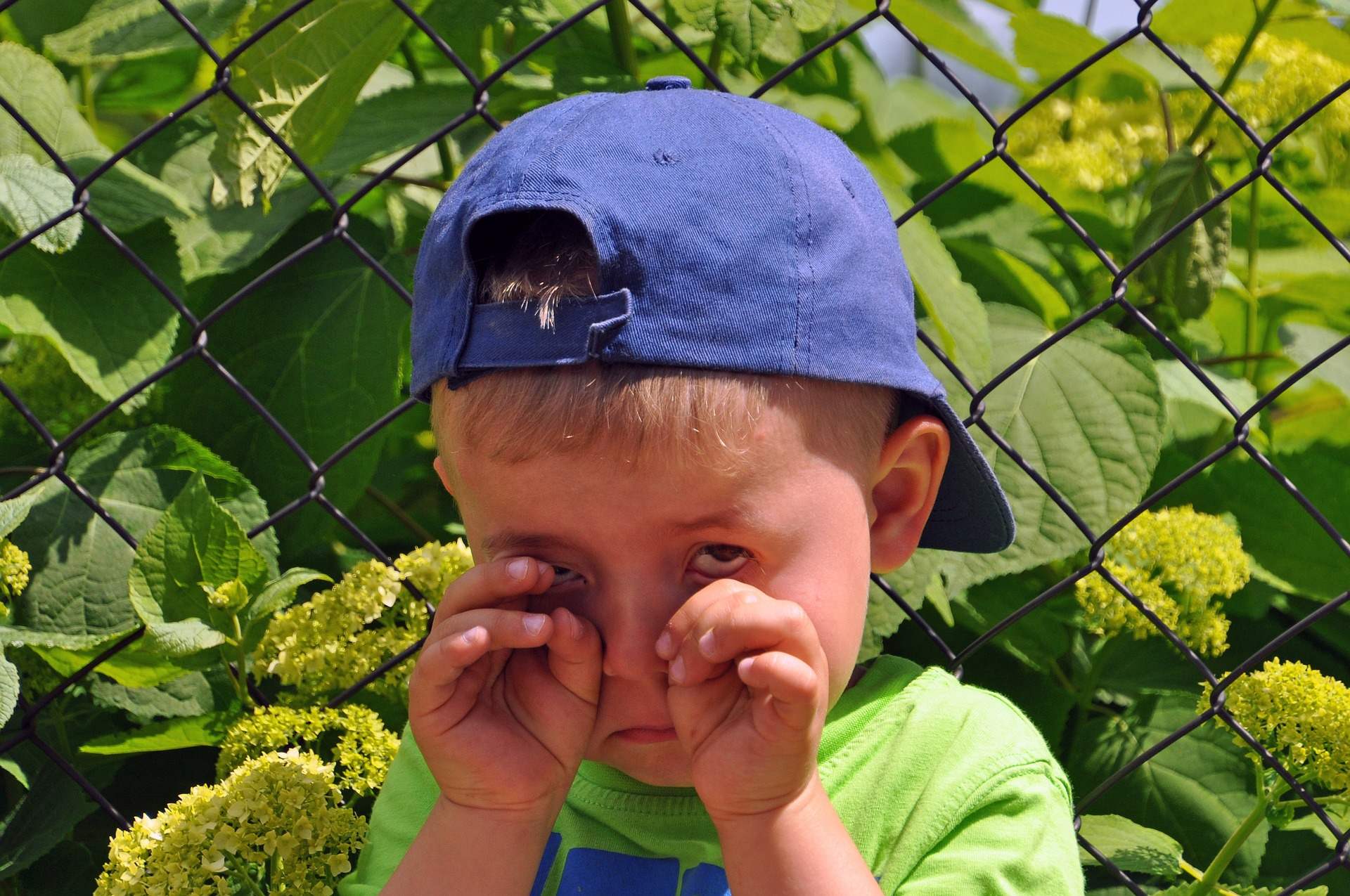
Breaking things during a tantrum
A lot of toddlers and children can end up breaking things when they are having a tantrum. This is also not an acceptable way for them to express their emotions, so it is good for you to stop that behaviour while still allowing their emotions to come out.
Redirect them to a different sensory experience similar to the breaking. A lot of children desire a sensory experience to help them calm down when they’re angry, that’s why sensory items are great for a calm down corner.
Once again, you can firmly but gently remove their hands from the thing they are breaking while redirecting them to something more appropriate while they are angry.
Hurting themself during a tantrum
Some children may choose to hurt their self during a tantrum. This could be very alarming, but again, stay calm.
They may be scratching their skin or pulling their own hair as they have their meltdown. This may show a need for a sensory experience during their tantrum.
Firmly but gently stop them from hurting their self as you say something like, “I’m going to remove your hand from scratching yourself because I need to keep you safe.” Then offer them another sensory interaction such as crumpling up a piece of paper or squeezing a pillow or another soft item.
If this behaviour seems to be persistent, don’t hesitate to talk to their doctor about it as if could have a deeper issue at the root of it.
#6. Specific Types of Tantrums
Is your child having tantrums due to really specific events? Here are some specific scenarios and how to handle them, but if you’re ready to go further into Gentle Parenting and to learn the basics so you can handle most behaviour situations with ease then be sure to sign up for my free course Gentle Foundations for Parenting.
Mealtime tantrums
Tantrums around food are really common for a lot of children, and there is a lot to be said about it. Since you already have specifics on how to help your child calm down and process the emotions of their tantrum, I’m just going to give you a few notes about meals.
Try to make meal time relaxed
Mealtime can become a stressful time for everyone in the house. You might be worried about how healthy your child is eating, that they’re not eating enough vegetables, or that they have a sweet tooth.
If your stress rubs off on them it can easily make mealtime a super tense part of the day. Instead mealtime should generally be a relaxed time of the day. Think about how you can cultivate a calm and relaxed mood around mealtime. The following tips might help to do that.
Don’t force them to eat when they’re full
If your child only eats one thing on their plate and leaves the other things, that’s ok. If they say they’re full it’s better to take them on their word than to force them to eat more. Instead, you want them to learn to listen to their bodies. Tearfully eating a food they feel really unsure about can create negative food relationships in the future.
Avoid putting any food on a pedestal
When we say something like, “You can have the candy after you eat your vegetables,” it puts candy on a pedestal and makes candy the more desirable food.
When we say, “If you eat the eggs today, tomorrow you can have cereal,” then it makes cereal the more desirable breakfast.
If a certain food is on a pedestal like this, then it can create food battles in the future, where of course your child desires this “treat” food over what you’re serving them. When all foods are created equal your child will see them equally, which can help to avoid tantrums over not being served candy for dinner.

You choose what to serve, they choose what to eat
A great rule to have in your family is that the parent chooses what to serve and the child choose what/how much of it to eat.
It’s good to make sure that on their plate is at least one familiar and well loved food, while you can also try out something new, or something they’re still learning to like. When you choose what to serve it can really help you not to feel stressed about the nutrition your child is getting. Sometimes just choosing not to buy foods you’d rather your child not eat often is much easier than refusing it to them if it’s in the house.
It is then your child’s choice to eat what is on their plate, and they don’t have to eat it all, and they don’t even have to take “at least one bite,” of everything. It’s ok for them to have this responsibility, they are learning to really listen to their bodies and you will be there to teach them and help them to know the benefits of different foods.
It’s ok if your child chooses to play with their food, since as I have learned from Jennifer Anderson from Kids Eat In Color that saying, “”Can you stack your squash?” can lead to eating.”
Playing with food is a great starting point to get comfortable with, and eventually eat that food!
Making just a few of these adjustments here can help you to avoid mealtime tantrums as you take the stress out of it!
Public tantrums
Dealing with public tantrums can be tricky business because often times we feel the pressure of onlookers, and we’re not in our usual environment. Of course, it’s great to do anything you can to prevent tantrums while out in public (ex. Stick to a routine, don’t go out during naptime, etc) but they’re still going to happen sometimes!
Most public tantrums happen when you’re at the grocery store, so my advice here will be specific to that.

Here are a few quick points.
- When the tantrums starts, focus completely on your child. Try ignore any judgemental looks from other customers or stress about getting down that last aisle. Give your child your full attention, that might be all they need.
- Leave the store (just leave your cart) and go out to the car together so your child can calm down. Not as a punishment, but as a tool to help them calm down. Shopping can be an overwhelming task for them. Getting your cold and frozen items last will make having to do this less stressful.
- Head to the check out once you see the tantrum brewing. It can be tempting to get everything off your list, but if you know your child might not make it through sometimes it’s safer just to finish the grocery trip today and get the rest tomorrow. This will help the trip to feel more like a “win” for your child. Alternatively, you can plan to do a lot of quick trips throughout the week to help your child get used to the grocery store and to figure out “how long is too long” for them to handle being at the grocery store.
Overall though, you’ll still want to use the same strategies I’ve taught thus far about handling your child’s tantrum. These types of tantrums though can be the most difficult because since we are in public we can REALLY want them to actually stop crying, even though at home that wouldn’t be our goal and we would happily allow them to cry and let out their feelings if that’s what they need to do. So it’s important to remember to stay calm.
Here is a great article from Happy You, Happy Family if you happen to have a lot of tantrums around toys at the store: How to Deal With Tantrums Over Toys at the Store
After-school meltdowns
After-school meltdowns are very common, and you might notice them the most at the beginning of the school year or after there has been a school break.
Let me explain why these sort of meltdowns happen!
Your child goes to school and they spend a lot of the time holding their emotions together! They feel embarrassment, disappointment, excitement, anger, etc. But they’re in front of their peers and their teachers, so they probably don’t feel 100% comfortable and so they hold a lot of their emotions back.
I think as adults we can understand this, have you ever held back tears because you didn’t feel comfortable crying in front of someone? Have you ever made it out of a social situation and when you get to your car you either cry or scream? You feel safe!
This is what happens for your child. They’ve held back a lot of emotions all day, and when you pick them up or they get home a lot of those emotions can come pouring out! Maybe it doesn’t seem like it’s “about” school, but deep down it really is.
Bear with them and know that you are their safe place, which is why a lot of this is being unloaded on you. Respond with love and comfort, and gain patience and strength from knowing that this is super normal. Help them to feel safe so they can let all those emotions out.
Bedtime meltdowns
Bedtime meltdowns are another common situation where your child might be having a tantrum. Try to make bedtime as relaxed and stress-free as possible. Having a solid routine and making sure to give them time with you as they wind down to go to sleep will be a big help.
When they do have a bedtime meltdown though just try to comfort them as we’ve already discussed and stay calm and relaxed. At this point they’re probably very tired, but they’re resisting going to sleep. You can be sure to teach them the importance of sleep and how their body needs sleep to help them understand. If they’re really having a hard time you can also try offering to do something relaxing to help them to calm down from the tantrum, and that will (bonus) help them fall asleep, such as reading an extra long story or rubbing their back.
When a child feels safe and secure it helps them to fall asleep. Remember, we want to bring them into our calmness, so by staying calm when they are having a tantrum as bedtime can help them to relax too. This can be really difficult as a parent though because by bedtime we are usually at the end of our strength too.
For more help with bedtime you can read this other article of mine: How to Overcome Bedtime Battles With Your Kids
#7. Conclusion
I hope this guide has been helpful for you. Tantrums can be one of the most difficult things for a parent to handle because our emotions can escalate as well.
If I can leave you with just one takeaway, it would be that our goal with tantrums isn’t to make our child stop crying or to prevent them from ever happening. Tantrums will happen.
But our goal should be that long term our child learns how to regulate their emotions.
A tantrum is an EMOTIONAL RESPONSE and not bad behaviour. It’s our job as the parent to make sure our child processes those emotions in a safe way (make sure no one gets hurt) and to give our child tools to process their feelings. The tools we teach them even as young toddlers will go with them throughout life. There are a lot of adults in this world with repressed emotions because that’s what they were taught to do as a child.
Instead, as Gentle Parents, we are going to be accepting and validating of the emotions, while teaching our children healthy ways to process their emotions.
Tantrums and meltdowns don’t have to be our breaking point as parents. You’ve got this!
BONUS GIFT
Make sure to download this tantrum script – it’s what to say while your toddler is having a tantrum!
If you print this or keep it saved on your phone it can really help while your toddler is having a tantrum! Most of the time when our toddler is having a tantrum we can start to feel frazzled and overwhelmed, and we can end up snapping or not knowing what to say.
Well problem solved! This script for tantrums can be a huge help and I made it specially for all the parents struggling with tantrums!

